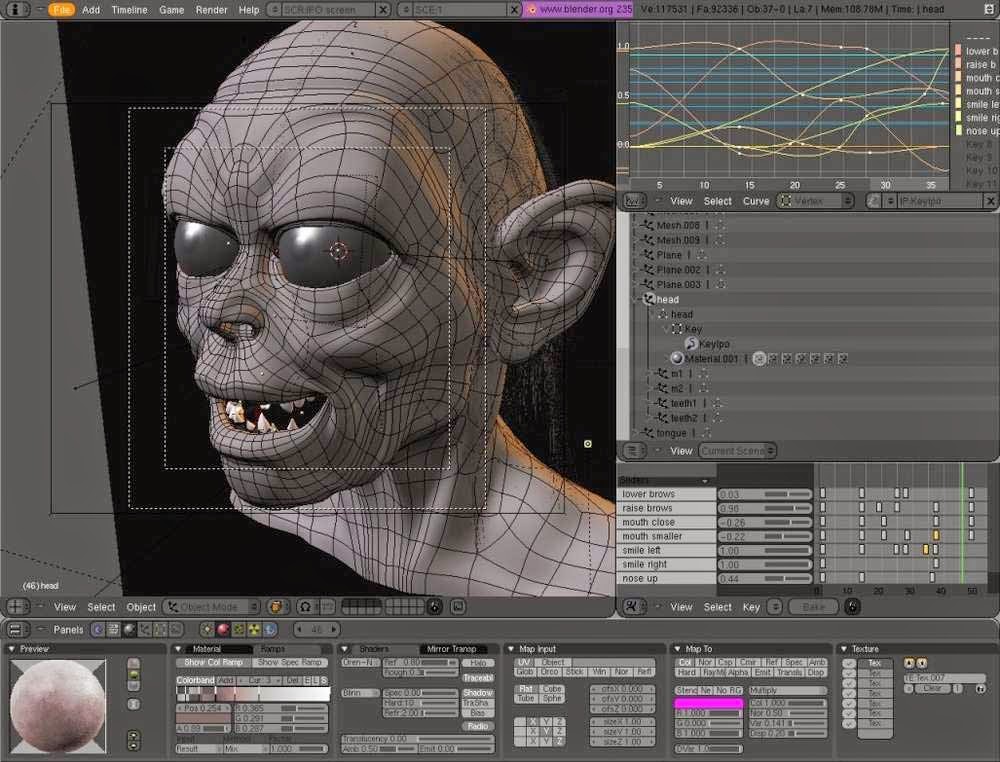

Try changing them around until you find what looks good. They correspond to the depth of the outline. Hit F9 again and find the Ext1 and Ext2 properties, shown here: Ext1 & Ext2.

In order to get the effect we're looking for here, we need to connect all of the points around the edge to make an outline (make sure not to connect the points across the picture or you'll have a messed up outline). You can't see it in the picture, but six of the points on the right side of the ear are connected, while the rest aren't. Here's what it should look like (I did the left ear): Tracing. Continue doing this until you have a complete outline (of the whole face or just one part, like the ear). Move the newly copied vertex to a point along the edge of the face a small ways away from the vertex you copied it from. Once this is done, select one of the end vertices of the curve (it doesn't matter which end) and use SHIFT+DKEY to copy that vertex. Do the same for all of the rest of the vertices, making sure you only have one vertex selected at a time or you'll move more than just the vertex you want to. Select one point at a time and using the GKEY move it to a point along the background image(or face in this case). Now there should be a few more vertices to work with and the curve should be just a bunch of joined lines. Hit F9 and, in Curve Tools, find and click the Poly button. Now, add a Bézier curve, and size it down a little. Zoom in to the new background image just a little bit. From there, select the picture you want to trace. It's the first one under the Use Background Image button.

Click the small button with a picture of a miniature folder on it (it looks kind of like a feather pen). Now some settings appear, we're only interested in one of them for this tutorial. A box should pop up with only one button in it (Use Background Image), click it. To do this, click 'view', then 'Background Image'. Before you start tracing the face, you need to set the face as the background image. Now open Blender and start a new project.I'm currently doing a project for a friend to do with devils and demons, so I chose a demonic looking face for this tutorial: Demonic Face First off, you're going to need a picture to trace.Stability for Blender can rely on your own content for source material - you shouldn't have to worry about legal trouble.Modeling a picture Įver seen an awesome looking picture you wanted to turn into a 3D model? Like a logo or a symbol? Well, it's actually pretty easy. However, it does hint at a way AI image generation can help creatives without as much risk of copyright issues. You'll need a tool like POINT-E for that. It also won't create 3D objects from scratch. This isn't likely to give Stable Diffusion a major advantage over rivals like OpenAI's DALL-E. It's safe to say this may be useful if you were already planning to use AI-generated art, as it could save you jumping between apps and services. It can also help you make truly custom content, Stability says. The addition theoretically saves time and money, and might help streamline your work. This might help if you need to complete some texture or video work on a laptop that isn't as robust as your main workstation.
Adding 3d to a photo blender software#
It doesn't require any software dependencies or a dedicated GPU.
Adding 3d to a photo blender free#
Stability for Blender requires an API (programming interface) key and an internet connection, but it's free to use. You may not need to be (or hire) a skilled 2D artist to put the finishing touches on a project. You can create AI-based textures, effects and animations, whether using source material from your renders or nothing more than a text description. Stability AI has introduced a Stability for Blender tool that, as the name implies, brings Stable Diffusion's image creation tech to the open-source 3D tool. Even 3D modelling software is using AI art generators.


 0 kommentar(er)
0 kommentar(er)
